Senior science journalist
Archaeologists have pieced collectively hundreds of fragments of two,000-year-old wall plaster to disclose outstanding frescoes that adorned an expensive Roman villa.
The shattered plaster was found in 2021 at a website in central London that is being redeveloped, but it surely’s taken till now to reconstruct this colossal jigsaw puzzle.
The frescoes are from at the least 20 partitions of the constructing, with superbly painted particulars of musical devices, birds, flowers and fruit.
The artwork is revealing extra in regards to the affluence of the realm the place they have been discovered – described by the group because the “Beverly Hills of Roman London”.
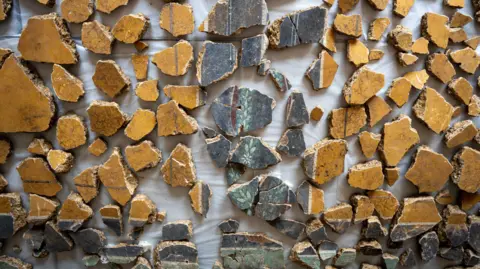 Tony Jolliffe/BBC Information
Tony Jolliffe/BBC Information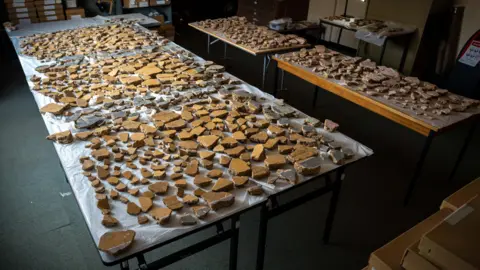 Tony Jolliffe/BBC Information
Tony Jolliffe/BBC InformationThere are additionally clues about who the artists have been: one fragment is scored with the Latin phrase Fecit, which suggests “has made this” – however the piece the place the identify must be is lacking.
The Museum of London Archaeology (Mola) group nonetheless hope the very important piece shall be discovered as they sift via the fragments.
“It is one of many largest – if not the largest – assemblages of Roman wall plaster and work we have ever present in Roman London,” stated Han Li from Mola.
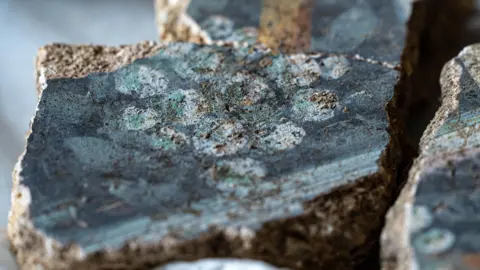 Tony Jolliffe/BBC Information
Tony Jolliffe/BBC InformationThe most important of the frescoes, measuring about 5m by 3m, has a decrease part of pale pink, dotted with specks of paint to mimic marble. Above are wealthy yellow panels with gentle inexperienced borders.
The wall work are adorned with candelabras, stringed devices known as lyres, white cranes and a fragile daisy.
There’s additionally what seems to be a bunch of grapes, however archaeobotanists imagine that this can be a plant that grows domestically – mistletoe.
“That’s truly fairly fascinating for me, since you’re seeing that the Roman painters are taking a classical thought they usually’re very a lot placing their very own North West European, or native, twist on it. I feel that is magnificent,” says Han Li.
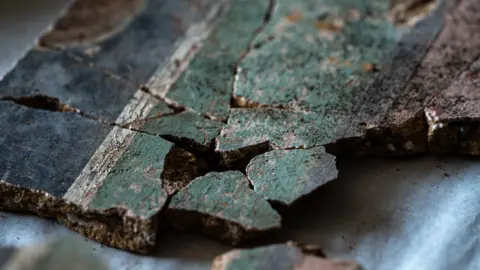 Tony Jolliffe/BBC Information
Tony Jolliffe/BBC InformationHe spent many months with the jumble of plaster, meticulously inspecting each bit to place collectively what he describes as “the world’s most troublesome jigsaw puzzle”.
The fragility of the traditional fragments made this much more of a problem.
“It’s important to be very cautious as a result of you’ll be able to solely assemble the items a small variety of instances earlier than the plaster begins to be broken and it flakes off,” he stated.
“So it’s a must to be fairly certain earlier than you be a part of the items that that is the piece that will match.”
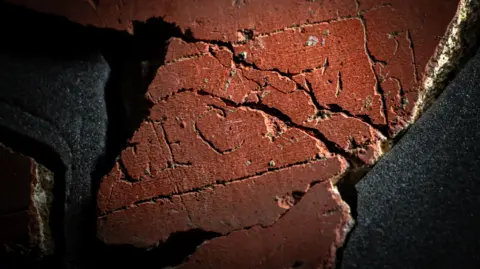 Tony Jolliffe/BBC Information
Tony Jolliffe/BBC InformationThe Romans based London in AD43, and the villa was constructed quickly after, courting to the primary or second century when the brand new metropolis was rising quickly.
The archaeologists suppose this grand constructing might have been residence to a rich household or a lodge for wealthy travellers passing via Londinium.
They have been evaluating the frescoes to others discovered throughout Britain and Europe, they usually imagine they have been created by a gaggle of extremely expert painters who travelled the Roman empire.
“They’ve come to Roman London the place there was a constructing increase, with many homes and lots of buildings going up that required portray. And so they went round primarily taking over enormous commissions of labor,” stated Han Li.
“It is wonderful to think about that their work is now once more seen to us 2,000 years later.”
The artists’ actual identification nevertheless will stay elusive till the lacking fragment bearing their names is discovered.
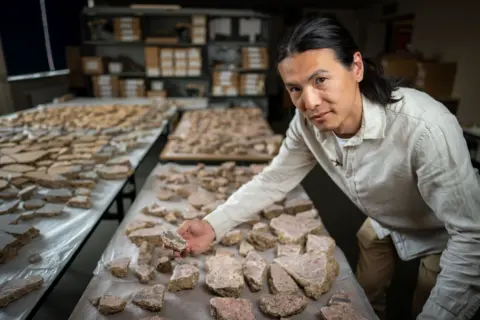 Tony Jolliffe/BBC Information
Tony Jolliffe/BBC InformationThe plaster was present in Southwark, simply south of the Thames. A surprising mosaic and Roman cemetery have been additionally unearthed on the website, which was being excavated in preparation for a brand new improvement.
This location, outdoors of the central hub of Roman London, can also be revealing extra about how town was spreading out.
“There was this thriving, bustling settlement fairly early on within the Roman interval, and it is virtually the form of rich suburb – the Beverly Hills of Roman London,” stated Andrew Henderson-Schwartz from Mola.
“And what this reveals is that the Romans are committing to London. They’re investing in London, they usually’re seeing it as a spot to settle in, a spot to remain. It is not only a form of provincial outpost.”
There’s nonetheless a lot to find from the fresco fragments, serving to archaeologists reconstruct the story of the UK’s wealthy Roman historical past.
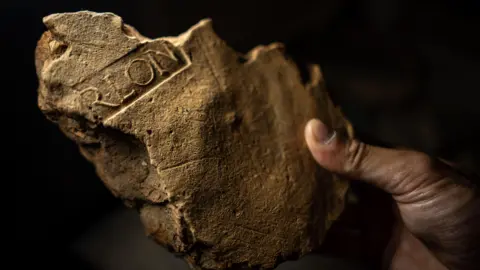 Tony Jolliffe/BBC Information
Tony Jolliffe/BBC Information
Get our flagship publication with all of the headlines you have to begin the day. Join right here.


